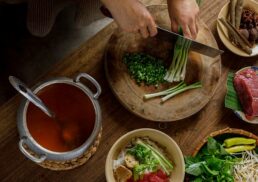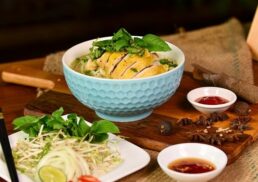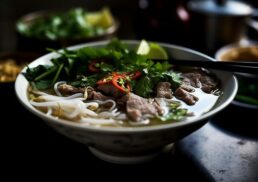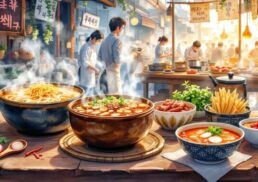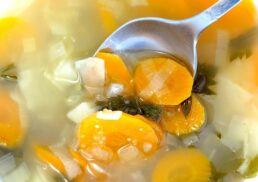Cuisine def means a style of cooking specific to a region or culture, including its ingredients, traditions, and culinary techniques. By understanding cuisine, we gain insights into the cultural identities and historical backgrounds that shape our food. This article will delve into the definition, origins, and cultural importance of cuisine.
Table of Contents
Key Takeaways
Cuisine encompasses unique ingredients, traditions, and cooking methods reflective of specific cultures or regions, serving as an essential aspect of cultural identity.
The word ‘cuisine’ has evolved from its Latin and French origins to signify a rich culinary tradition, showcasing the history and heritage of various cultures.
Modern trends in cuisine, such as fusion cuisine and the farm-to-table movement, illustrate the ongoing evolution of culinary practices influenced by cultural exchanges and innovations.
Cuisine Def: Understanding the Meaning and Importance

Cuisine is a type of cooking that reflects specific ingredients, traditions, and regional practices of a culture. It is deeply tied to cultural or geographical contexts, encompassing the culinary specialties unique to a country or culture, including specific cooking methods and ingredient preparations.
The term ‘cuisine’ entered English in the late 18th century, evolving from its Latin roots through French to English. This shift shows how its meaning expanded from a simple term for kitchen to broader culinary practices.
Knowing the cultural origins of food enhances appreciation and fosters connections among diverse culinary practices in our globalized world.
Introduction
Cuisine is a vital part of cultural identity, shaping social interactions and traditions. More than just food, it includes traditions, techniques, and ingredients unique to a region or culture. Traditional dishes reflect cultural identity and heritage, preserving history and customs.
Local ingredients, climate, and trade contribute to the diversity and uniqueness of global cuisines. Each cuisine embodies regional variations with distinct flavors, techniques, and cultural significance. Appreciating these variations reveals the rich tapestry of global food culture.
Definition of Cuisine
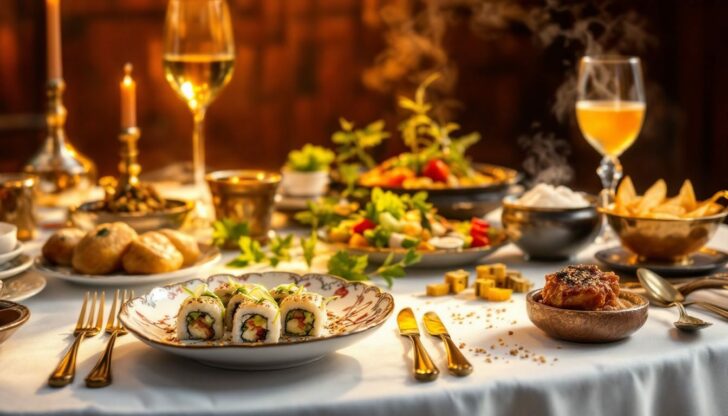
Cuisine refers to a style of cooking featuring unique ingredients and techniques, often linked to a specific culture or region. It reflects the ingredients, traditions, and practices of a culture, creating a recognizable and celebrated culinary identity globally.
Cuisine is a style of cooking tied to specific cultural or geographical contexts. The word ‘cuisine’ entered English in the late 18th century, evolving from Latin to French. Its meaning shifted from a simple term for kitchen to encompass broader culinary practices.
Historical Origins of the Word Cuisine
The word cuisine originates from French, indicating a ‘style of cooking,’ and has been used in English since the late 18th century. Its adoption underscores culinary traditions.
The Latin root ‘coquere’ means ‘to cook’, and ‘late latin coquīna’ refers to a kitchen, both contributing to the term ‘cuisine’. Over time, it has come to signify a rich culinary tradition reflecting cultural heritage and cooking, including the concept of latin coquere.
Factors Influencing Cuisine
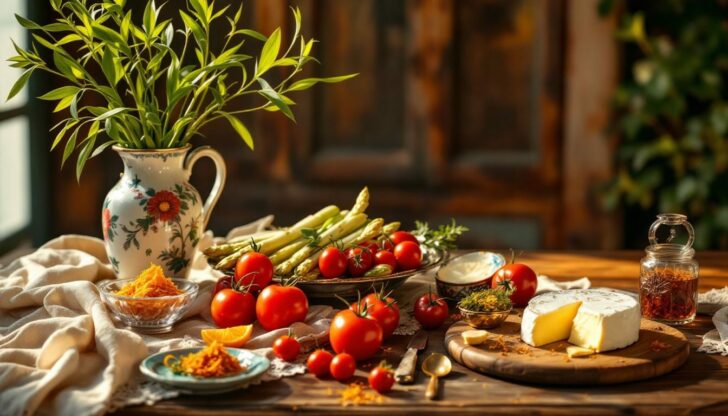
Local ingredients and trade shape regional cuisines, creating unique cooking styles reflective of the area. Regional cuisines emerge from local resources, historical trade routes, and cultural influences, leading to distinctive culinary identities.
Geography, climate, and cultural exchanges also shape differences in cuisines. For example, the quality and seasonality of regional ingredients are significant in Italian cuisine, characterized by fresh, high-quality ingredients and regional specialties. These factors contribute to the rich diversity of global cuisines.
Regional Variations in Cuisine
Regional variations in cuisine are vast, influenced by ingredient availability, cooking traditions, and cultural differences, including local cuisine.
The following subsections explore specific examples of regional cuisines, including French, Italian, and Southeast Asian cuisines, each with unique characteristics and cultural significance.
French Cuisine
French cuisine is renowned for its use of high-quality, fresh ingredients and sophisticated cooking methods, contributing to its excellent cuisine. Fresh ingredients are fundamental to creating the flavorful dishes that are hallmarks of French cuisine, including food prepared with care.
Sophisticated cooking methods enhance the complexity and presentation of dishes, showcasing the skill and artistry involved in French cooking. Rich flavors are achieved through careful selection and combination of ingredients, often featuring herbs, spices, and sauces.
Italian Cuisine
Italian cuisine prominently features local products such as cheeses, tomatoes, and olive oil, shaping its signature dishes. Regional diversity is a defining characteristic, with variations in ingredients and recipes across different areas.
The use of regional ingredients and recipe diversity have greatly influenced international cuisine, leading to the global popularity of Italian food.
Southeast Asian Cuisine
Southeast Asian cuisine is distinguished by vibrant and spicy cuisine flavors, heavily relying on fresh herbs and locally sourced ingredients. Ingredients like lemongrass, fish sauce, and coconut milk are frequently incorporated, giving these dishes their distinctive flavors.
Modern Trends in Cuisine
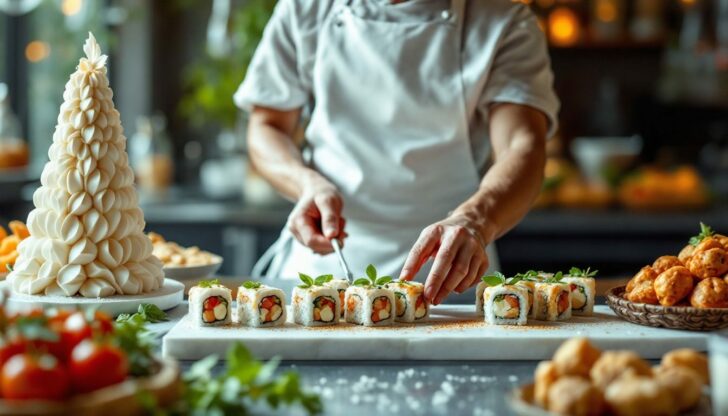
Cuisines evolve over time, influenced by innovations and cultural exchanges, creating new culinary styles. Fusion cuisine thrives as chefs blend different culinary traditions to create innovative dishes. Molecular gastronomy emphasizes scientific techniques to enhance flavors and presentation. The farm-to-table movement focuses on sourcing local ingredients, promoting freshness and sustainability.
Emerging ingredients like seaweed, known for its umami flavor and health benefits, and mushrooms, celebrated for their rich flavor and nutritional profile, are becoming popular in various dishes. The trend of ‘swicy’ foods combines sweet and spicy flavors, often with honey, creating unique taste experiences. Plant-based baking is also on the rise, with alternative ingredients replacing traditional ones like eggs and milk.
The Role of Cuisine in Culture

Cuisine is a crucial aspect of cultural identity, often reflecting a community’s historical roots, values, and traditions. It showcases a community’s history, beliefs, and lifestyle through its ingredients and cooking methods.
Food serves as sustenance and as a medium for expressing cultural heritage and connecting with others. Traditional cooking methods and recipes are vital components of cultural heritage, passed down through generations, conveying historical narratives and cultural legacies.
Seasonal and regional festivals often center around specific foods, reflecting local agricultural practices and cultural traditions. Understanding cuisine enhances appreciation for diverse cultures and fosters respect for various culinary traditions. Sharing meals strengthens bonds within communities and preserves traditional customs.
Preparing Food: Techniques and Methods
French cuisine is characterized by meticulous techniques, where presentation and aesthetics are as important as flavor. French cooking emphasizes technique, often utilizing intricate preparation methods requiring rigorous training.
Various cooking methods such as braising, poaching, sous vide, steaming, grilling, baking, frying, and broiling are employed to prepare food. Braising combines dry and moist methods by searing food first and then slow-cooking it in liquid, resulting in tender, flavorful dishes. Poaching gently cooks food in simmering liquid, preserving delicate textures and flavors without using fat.
Sous vide, meaning ‘under vacuum,’ allows food to be slow-cooked in a sealed bag submerged in hot water, resulting in juicy and evenly cooked dishes. Steaming preserves moisture and nutrients, making it ideal for cooking vegetables and delicate proteins. Each method brings out different qualities, showcasing the versatility and artistry involved in cooking.
Cuisine in Restaurants
Cuisine in restaurants is a critical aspect of the dining experience, reflecting culture, creativity, and the artistry of food preparation. Chefs and the culinary department play a key role in the restaurant industry, influencing menu design, food presentation, and overall dining experience.
Restaurants focusing on plant-based menus are becoming increasingly popular, attracting diverse clientele with innovative cuisine concepts that enhance customer engagement and satisfaction.
Learn more, visit The History of Cuisine – My Culinary Joy.
Summary
Understanding the meaning and importance of cuisine provides a deeper appreciation for the diverse culinary practices around the world. From its historical origins to modern trends, cuisine reflects cultural heritage, social interactions, and innovative culinary techniques.
Cuisine is more than just food; it is a cultural expression that connects us to our past, enriches our present, and inspires our future culinary adventures. By exploring the various aspects of cuisine, we gain a greater respect for the rich tapestry of global food culture and the intricate artistry involved in preparing food.
Frequently Asked Questions
What is the definition of cuisine?
Cuisine is a style of cooking characterized by unique ingredients, techniques, and dishes associated with a particular culture or region. This definition highlights the cultural significance of food preparation and consumption.
How does cuisine reflect cultural identity?
Cuisine reflects cultural identity by embodying a community’s history, beliefs, and lifestyle through its unique ingredients and cooking techniques. This connection reinforces the essence of the culture itself.
What are some modern trends in cuisine?
Modern trends in cuisine prominently feature fusion cuisine, molecular gastronomy, and farm-to-table movements, alongside the incorporation of emerging ingredients such as seaweed and mushrooms. These trends reflect a growing emphasis on sustainability and innovation in culinary practices.
What role do restaurants play in popularizing cuisine?
Restaurants play a vital role in popularizing cuisine by showcasing cultural elements, creativity, and culinary artistry, thereby enhancing customer engagement and satisfaction. Their influence helps shape dining trends and broadens the audience for diverse food experiences.
How do cooking techniques vary in different cuisines?
Cooking techniques differ significantly across cuisines, with methods like braising, poaching, and grilling each enhancing the flavors and textures of the food in unique ways. Understanding these techniques is essential for appreciating the diversity of global culinary practices.
